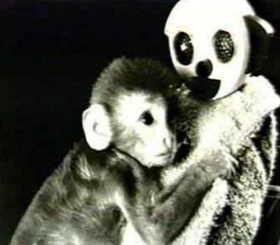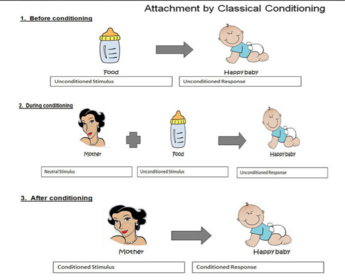A-Level Psychology (Attachment) Flashcards on Psychology - Attachment, created by Emily Sutton on 06/04/2016.
Pinned to
41
5
0
No tags specified

|
Created by Emily Sutton
over 8 years ago
|
|
Close

|
Created by Emily Sutton
over 8 years ago
|
|

Psychology - Attachment:
Infant-caregiver interactions in humans, animal studies of attachment and learning theory as an explanation for attachment.
Caregiver-Infant Interactions in Humans
Reciprocity
AO3:
Reciprocity influences the child’s physical, social and cognitive development.
Interactional Synchrony
AO3
Heimann showed that infants who demonstrate a lot of imitation from birth onwards have been found to have a better quality of relationship at 3 months.
Stages of Attachment Identified by Schaffer
Indiscriminate attachments (6 weeks to 7 months) - Infants indiscriminately enjoy human company and most babies respond equally to any caregiver. They get upset when an individual ceases to interact with them. From 3 months infants smile more at familiar faces.
Multiple attachment (10 months and onwards) - The baby becomes increasingly independent and forms several attachments. By 18 months the majority (31%) of infants have form multiple attachments.
Multiple Attachments
The Schaffer and Emerson study has low population validity.
Role of the Father
AO3
Numerous factors effect the father's role and the impact he has on his child's emotional development. For example, culture, father's age, and the amount of time the father spends away from home. So many factors means it difficult to make generalisations about the father's role.
Biological factors:
Men seem to lack the emotional sensitivity to infant cues (Heerman, et al. 1994) that women offer spontaneously this could be due to the fact that women produce a hormone, oestrogen which increases emotional response to other’s needs.
Animal Studies of Attachment

Both groups of monkeys spent more time with the cloth mother (even if she had no milk).
Harlow’s work has been criticized. His experiments have been seen as unnecessarily cruel (unethical) and of limited value in attempting to understand the effects of deprivation on human infants.
Lorenz's Imprinting Theory
When the geese hatched Lorenz imitated a mother duck's quacking sound, upon which the young birds regarded him as their mother and followed him accordingly.
Imprinting does not appear to be active immediately after hatching, although there seems to be a critical period during which imprinting can occur.
Explanations of Attachment

AO3:
Schaffer and Emerson found less than half of infants had a primary attachment to the person who usually fed them.
Harlow’s research suggested monkeys became attached to the soft surrogate mother rather than the one who fed it. This goes against the learning theory of attachment.

 Hide known cards
Hide known cards